Operating with poor visibility risks patient safety. In minimally invasive surgery, the display is the surgeon’s only view into the body. Any screen flaw directly compromises the procedure.
Details on the critical role of medical displays in endoscopic surgery follow. We will cover how resolution, color, viewing angles, durability, and integration features directly impact surgical precision, team efficiency, and patient outcomes.
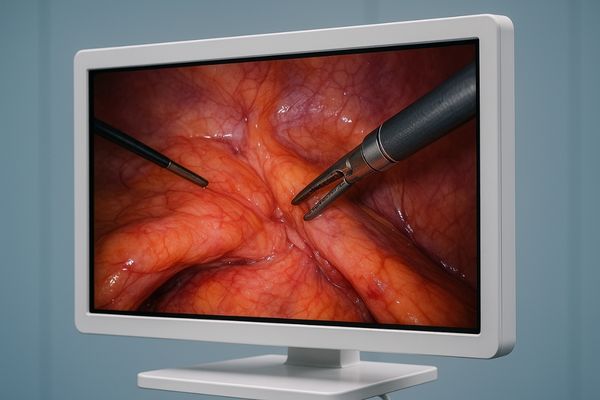
In modern endoscopic surgery, the monitor is not just a screen; it is the surgeon’s eyes. Every decision, every movement, and every delicate dissection is guided by the image it presents. A standard commercial display simply cannot meet the demands of this environment. The specific technical attributes of a medical-grade surgical display1 are fundamental to the success and safety of minimally invasive procedures2. Understanding these attributes is essential for any healthcare provider committed to surgical excellence.
High-definition displays provide critical visual clarity for endoscopic navigation
Navigating delicate anatomy with a blurry image is dangerous. This lack of detail can lead to unintended tissue damage. High-definition displays provide the clarity needed for safe, precise surgical work.
In endoscopic surgery, the display becomes the surgeon’s eyes. Any compromise in image quality, such as low resolution or poor contrast, could directly impact patient safety and the success of the procedure.
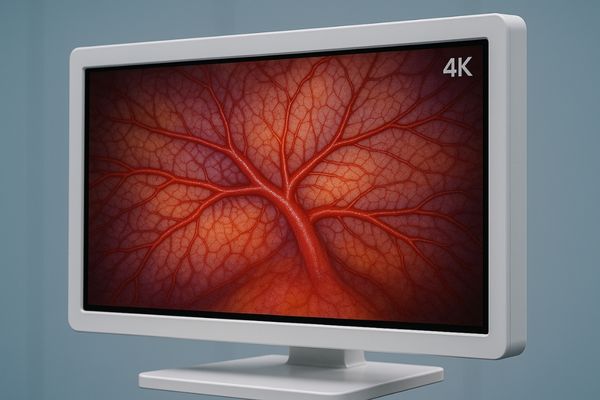
The primary function of an endoscopic display is to provide a clear, detailed view of the surgical field. During a laparoscopic procedure, the surgeon must be able to identify extremely fine anatomical structures, such as nerves, small blood vessels, and the margins of a tumor. A standard-definition display blurs these details together, creating a significant risk of accidental injury. High-definition (HD) and 4K Ultra HD (UHD) displays3 offer a dramatic increase in pixel density. This higher resolution translates directly into a sharper, more detailed image. With a monitor like our MS275P, surgeons can visualize the operative site with lifelike clarity. This allows for more precise dissection, better preservation of critical structures, and a reduced risk of complications. The transition to 4K is not a luxury; it is a fundamental step toward enhancing surgical precision4 and improving patient safety.
Resolution’s Impact on Surgical Tasks
| Surgical Task | Low-Resolution Display Risk | High-Resolution Display Benefit |
|---|---|---|
| Nerve Sparing | Nerves appear blurred or are indistinguishable from surrounding fascia. | Nerves are clearly defined, enabling precise dissection around them. |
| Vessel Ligation | Small perforating vessels may be missed, leading to bleeding. | Even the smallest vessels are visible for accurate cauterization or clipping. |
| Tumor Margin Identification | The boundary between healthy and diseased tissue is unclear. | Sharp image allows for precise excision with clear margins. |
Accurate color and contrast help surgeons differentiate tissue types during procedures
Washed-out colors on a screen can hide pathology. This problem makes it hard to distinguish healthy tissue from inflamed or ischemic areas. Accurate color rendering reveals these critical visual cues.
Subtle visual cues in tissue, such as variations in vascularity or lesion texture, are only recognizable on a display with high fidelity. Excellent color reproduction and high contrast are crucial for intraoperative diagnosis and decision-making.
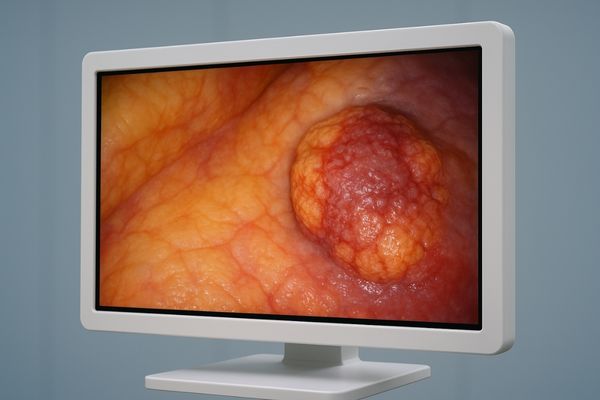
Beyond just sharpness, the ability to accurately reproduce color is vital in endoscopic surgery. The color of tissue provides the surgeon with a wealth of information. For instance, the subtle difference in redness can indicate inflammation, while a bluish tint may suggest a lack of blood flow (ischemia). A display with a wide color gamut5 and precise calibration ensures that these subtle hues are rendered faithfully. Furthermore, a high contrast ratio6 is essential. It allows surgeons to see detail even in shadowy areas or when the view is partially obscured by surgical smoke or fluids. Our MS321PC is designed to deliver deep blacks and bright, saturated colors. This capability helps surgeons to confidently identify different tissue planes, assess tissue viability, and recognize pathological changes in real time. This is fundamental for achieving the best possible surgical outcome.
Wide viewing angles and consistent brightness support team collaboration in the OR
When staff cannot see the screen clearly, collaboration suffers. Assistants viewing from an angle may see a distorted image. A display with wide viewing angles ensures the entire team is on the same page.
Display consistency across different viewing angles is essential for the operating room. It ensures that assistants, nurses, and technicians can clearly follow the surgeon’s actions, which improves overall teamwork and surgical workflow.
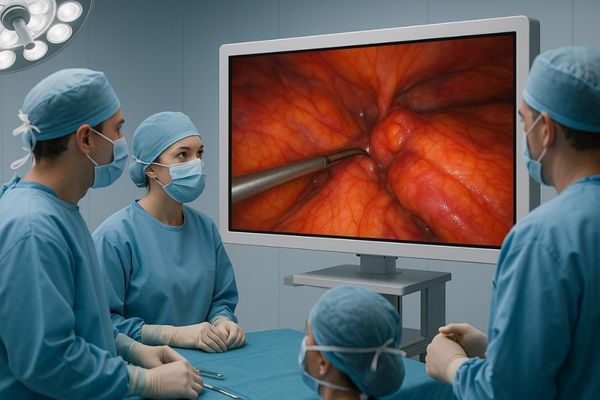
An endoscopic procedure is a team effort. The surgeon, surgical assistants, and nurses all rely on the surgical display7 to follow the progress of the operation. In a crowded operating room, team members are naturally positioned at various angles to the monitor. A standard display often suffers from color and contrast shifts when viewed from off-center. This means an assistant might see a darker, less detailed image than the primary surgeon. This hinders their ability to anticipate needs and provide effective support. We equip our displays, such as the large-format MS430PC, with panels that offer wide viewing angles8 of 178 degrees. This technology ensures that the image remains consistent in color, brightness, and contrast, no matter where a person is standing. This shared, consistent view fosters better communication, improves team synchronization, and contributes to a safer and more efficient surgical environment.
Multi-window capabilities enable simultaneous viewing of live feed, patient data, and instrument tracking
Toggling between different information sources is a distraction. A surgeon looking away from the operative field can lose focus. Integrating all necessary data onto one screen is the solution.
Multi-window displays allow surgeons to view the live endoscopic feed alongside other critical data in real time. This capability enhances spatial orientation and provides comprehensive information without diverting the surgeon’s attention.
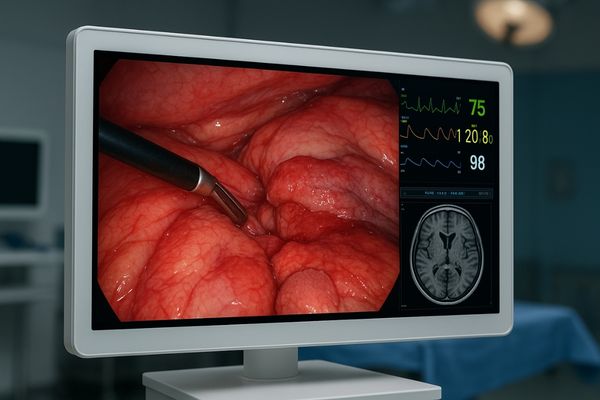
Modern surgery is increasingly data-driven. During a procedure, a surgeon may need to reference pre-operative imaging, monitor live patient vitals, or track navigational instruments. A display with multi-window functionality9 consolidates this information onto a single screen. For example, a surgeon can have the live endoscopic video as the main image, with a smaller window showing the patient’s heart rate. This integrated view provides crucial context without requiring the surgeon to turn their head to a separate monitor. Our MS550P offers the screen real estate and processing power to manage these multiple inputs seamlessly. This creates a centralized command center for the surgeon, improving their situational awareness10 and supporting more informed intraoperative decision-making.
Common Multi-Window Surgical Setups
| Window 1 (Main) | Window 2 (PbP/PiP) | Window 3 (PbP/PiP) | Primary Benefit |
|---|---|---|---|
| Live Endoscopy | Pre-operative MRI/CT | Patient Vitals | Anatomic correlation and safety checking. |
| Live Laparoscopy | Intraoperative Ultrasound | Instrument Navigation | Real-time fusion and precise tool tracking. |
| 3D Endoscopy | Pathology Slides | Anesthesia Data | Comprehensive case review and team awareness. |
Display durability and cleanability ensure compliance with sterile field requirements
Consumer-grade displays are not built for the OR. Their vents and seams can harbor pathogens, posing an infection risk. A sealed, cleanable design is essential for maintaining a sterile environment.
A display built for the OR must be sealed and made of robust materials. This design allows for rigorous cleaning and meets strict hygienic standards to prevent infection.
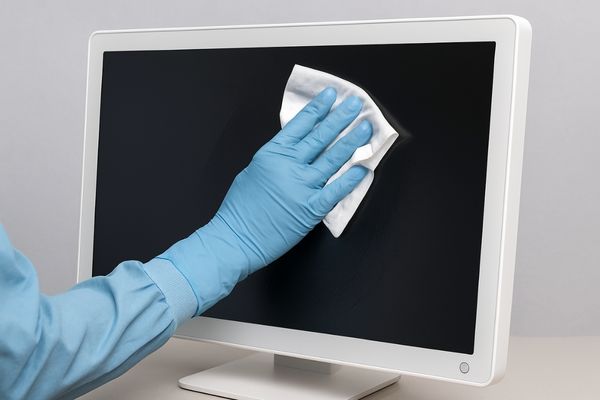
The operating room is a sterile environment where infection control is paramount. Every piece of equipment must be designed to withstand rigorous cleaning and disinfection protocols. Standard monitors have vents for cooling and gaps in their bezels, which can trap fluids and microorganisms. This makes them impossible to properly sterilize. Medical surgical displays11 are engineered differently. They feature a sealed, fanless design with a seamless front surface, often protected by a single pane of glass. This smooth, gap-free construction eliminates potential harbors for bacteria. Furthermore, the housing is made from materials that are resistant to harsh chemical disinfectants. Models like our MS270P carry an IP rating12, certifying their resistance to dust and liquid ingress. This purpose-built design is a non-negotiable requirement for patient safety and compliance with sterile field protocols.
Integration with recording and broadcasting systems enhances surgical teaching and documentation
Recording surgery with a phone camera is unprofessional. It produces low-quality video unsuitable for teaching or legal records. Professional-grade integration ensures high-quality documentation.
Medical displays must integrate seamlessly with OR recording and broadcasting systems. This is crucial for creating high-quality documentation for medical records, resident training, and academic presentations.
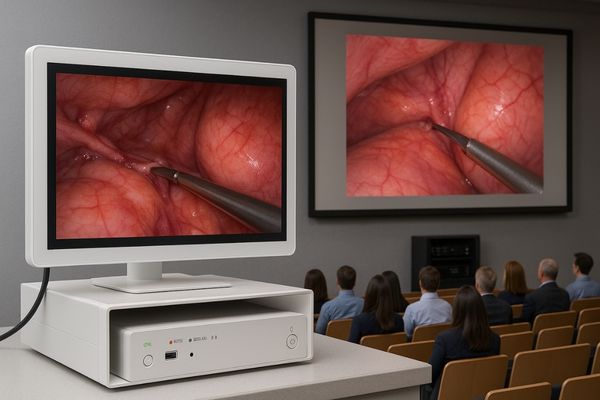
Surgical procedures are frequently recorded for teaching, documentation, and medico-legal purposes. The surgical display13 is a key link in this chain. It must be able to receive a signal from the endoscopic camera and then output that same high-quality signal to external recording devices. This requires versatile connectivity options, such as SDI and DVI outputs, which are standard in professional video environments. The display’s internal video processing must also be flawless to ensure there is no signal degradation or added latency. A display like our MS247SA is designed with this connectivity in mind. It ensures that the video recorded is an exact replica of what the surgeon sees during the procedure. This is essential for effective surgical training and creating a precise, reliable medical record.
Reshin offers tailored display solutions designed specifically for endoscopic applications
Using a general-purpose display for endoscopy is a compromise. These screens lack the specific features needed for a demanding surgical environment. A specialized solution from a focused manufacturer is the better choice.
I founded this company specifically to create tailored medical display solutions. Our endoscopic monitors combine optical performance with surgical-specific features to meet the real-world demands of the modern operating room.
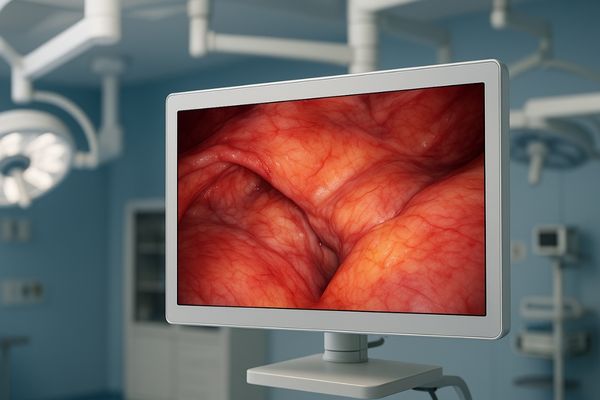
We are a specialist monitor manufacturer dedicated to medical imaging14. I have channeled my extensive experience in surgical imaging systems15 into creating displays that are purpose-built for the operating room. We understand that endoscopic surgery requires more than just a sharp picture. That is why our monitors, from the versatile MS220S to our advanced 4K models, incorporate features tailored to this environment. This includes anti-reflection coatings to minimize glare from surgical lights, automatic brightness adjustment to maintain a consistent view, and the robust, cleanable designs that infection control protocols demand. Our focus is not on adapting consumer technology. We engineer solutions from the ground up to enhance surgical precision, improve workflow, and ultimately contribute to better patient outcomes.
Conclusion
The right medical display is a fundamental pillar of modern endoscopic surgery. By providing superior clarity, color, and reliability, these specialized tools empower surgeons to perform at their best.
📧 Looking to enhance your endoscopic surgery setup with high-performance displays? Contact Martin at martin@reshinmonitors.com for expert solutions from Reshin.
-
Explore this link to understand how medical-grade displays enhance surgical precision and safety in minimally invasive procedures. ↩
-
Discover the benefits of minimally invasive procedures, including reduced recovery time and improved patient outcomes. ↩
-
Explore how HD and UHD displays enhance surgical precision and patient safety, making them essential in modern operating rooms. ↩
-
Understanding the importance of surgical precision can help you appreciate advancements in medical technology and their effects on recovery. ↩
-
Understanding color gamut is crucial for surgeons to accurately interpret tissue colors, enhancing surgical precision and outcomes. ↩
-
Exploring high contrast ratio benefits can reveal how it aids surgeons in seeing details in challenging conditions, ensuring better surgical results. ↩
-
Learn about the critical role of surgical displays in ensuring effective communication and support during procedures. ↩
-
Explore how wide viewing angles enhance surgical teamwork and improve patient outcomes. ↩
-
Explore how multi-window functionality enhances surgical efficiency and decision-making during procedures. ↩
-
Learn about the importance of situational awareness in surgery and its effect on patient safety and outcomes. ↩
-
Explore how Medical surgical displays enhance infection control in operating rooms, ensuring patient safety and compliance. ↩
-
Learn about the significance of IP ratings in medical equipment, ensuring durability and safety in sterile environments. ↩
-
Understanding surgical displays can enhance your knowledge of their role in medical training and documentation. ↩
-
Explore this link to stay updated on cutting-edge medical imaging technologies that can enhance surgical procedures. ↩
-
Discover how advanced surgical imaging systems can significantly impact patient care and surgical efficiency. ↩


